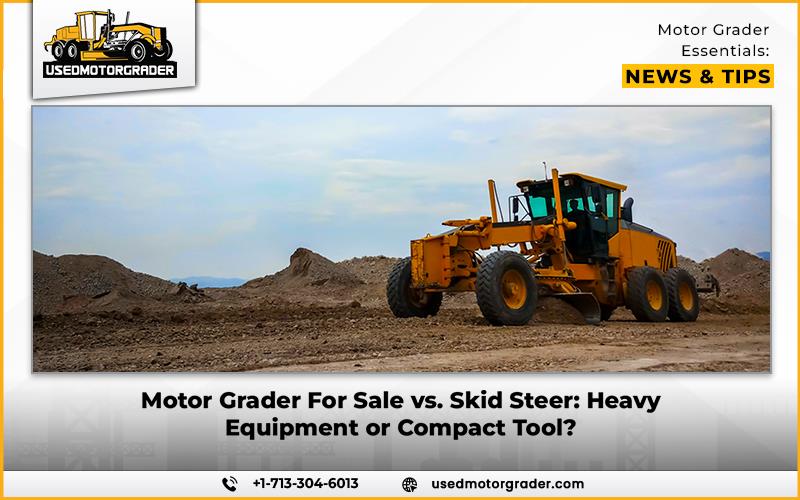A contractor should not consider one machine better than another because different jobs require specific equipment types. Understanding how motor graders and skid steers work best fits different tasks helps you save time, money, and avoid problems on your site. Let’s examine how specific job requirements help you decide between a motor grader for sale and a skid steer.
The Core Functions of Each Machine
Motor graders carry out separate tasks from skid steers. Motor graders are designed to deliver exact grading results in weighty applications. This machine creates level areas while working over big stretches and shaping terrain through its strong blade and sturdy frame. The machine works like an expert medical professional who can alter terrain by tiny amounts.
A skid steer works as a universal machine in compact equipment because of its many features. Its compact form and adjustable tools make the device perfect for multiple tasks in limited areas. The machine performs basic grading tasks but lacks expertise in any specific area.
Terrain and Project Scale: Where Each Machine Thrives
Your workspace design primarily affects what equipment you need to choose. Motor graders work effectively in open land areas. These heavy equipment delivers perfect blade pressure across extended rural roads because they stay stable on irregular ground. Its heavy build and stable platform keep the machine steady during tough ground conditions.
Skid steers excel in confined spaces because their small design lets them turn sharply. Projects in urban settings, such as parking lots and alleys, do not have enough room for a grader because of its large size. A skid steer moves easily between obstacles while passing through narrow spaces and grading small areas without damaging the nearby infrastructure.
Precision vs. Flexibility: What’s Your Priority?
Motor graders provide exact results in their operations. Engineers can use grader tools to modify blade angles which let them build exact slope gradients and drainage channels. Engineering projects that need to follow technical standards depend completely on the unique shaping abilities of the grader.
The skid steer offers more flexibility than it does precise control. The grading blades on these machines do not match a grader’s precision but they can easily transition between digging, lifting and loading work. You need to grade a limited space before digging a trench and moving away the leftover materials. A skid steer equipped with suitable attachments can perform any task required on-site.
Budget and Operational Costs: More Than Just the Price Tag
The total purchase price defines the most significant difference between these machines. New machines like motor graders require significant investments reaching above $300,000 while skid steers purchase costs range between $50,000 up to $70,000. The intricate nature of graders keeps their prices elevated, even though used equipment creates price reductions.
Operational expenses also vary. Motor graders use more fuel than other machines and need special operators who earn better pay, while their repairs need expensive parts. Skid steers use less fuel than other machines and require minimal service work, while operators who lack experience can easily handle them. When you need to grade large areas, you will probably save money despite spending more on a grader per hour.
Attachments and Customization: Tailoring to Your Needs
Skid steers shine here. The machine works with multiple snowblowers trenchers and pallet forks to handle many different projects. Small business owners can serve multiple tasks with just one machine because of this flexibility.
Motor graders offer basic upgrades because their specific work attachments are designed for heavy-duty applications. Snow wings spread out fully to clean wide roadways, and rippers detach to loosen packed dirt. Upgrades for these machines do not create new capabilities, yet they boost the grader’s main ability to shift heavy loads quickly.
Future-Proofing Your Investment: Technology Trends
The rise of automation and electrification is reshaping both markets. Projects on large sites run more smoothly because motor graders receive guidance from GPS and grade-control systems, which make fewer errors and produce better results. The system includes an automatic mode for repeated operations.
Skid steers are going electric. Battery-powered equipment achieves market success in urban areas because it produces no emissions and makes less noise compared to traditional models. Despite their limited capacity for heavy-duty grading work electric models perform better than other options for small eco-friendly tasks.
Environmental and Regulatory Considerations
In certain areas motor graders need to meet strict emission standards because they run on diesel engines and have large weight distribution. Organizations may need to restrict their use of these machines in urban areas. The electric skid steer operates better than conventional construction vehicles under emissions control rules.
That said, graders are evolving. New hybrid solutions and biodiesel capabilities are now available for motor graders, yet they still add cost to the equipment. Currently, skid steers represent a more environmentally friendly solution than other equipment for short-term operations.
Making the Right Choice: Key Questions to Ask
Before deciding, ask yourself:
How much space do I have? A space with limited room calls for a skid steer, but opens up opportunities for a grader.
What’s the project timeline? The grader machine operates more quickly in large areas, but the skid steer tool saves time across many different project tasks.
What’s my long-term need? You should rent a grader for temporary grading work instead of purchasing one, since the need is short-term.
The best choice depends completely on conditions. A motor grader helps build infrastructure due to its immense strength and exact control whereas a skid steer proves useful daily through its small size and budget-friendly performance. Your decision should depend on the type of work you need to do with your equipment. When you know how the tool differences affect your job you select the right machine for your needs instead of just a big or low-priced one.


